Moving to Italy: Trump’s victory leading thousands of Americans seeking pasta, vino and calm seas

I’m old enough to remember the Fall of Saigon and that 1975 photo of desperate people airlifted off a rooftop to safety. That image has returned. This time, the image has altered but the intention remains the same: People flooding LAX’s international terminal. Streams of cars jamming entry ramps onto freeways. A line of hitchhikers holding up signs reading “CANADA” with an arrow pointing up.
My list of friends, contacts and readers asking for advice on moving to Italy is longer than my last blog about my love of living in Italy. Last Tuesday’s disastrous election results for democracy and human decency have Americans wanting out. Whether it’s leaving a country doomed to third world chaos or an inability to stomach the company of 72 million voters who think Donald Trump should again lead the free world, I don’t know.
The people don’t give me a reason. No need. The point is, they want out. Where to go? Hmmm. Well, they hear Italy is nice. I retired to Rome 10 years ago and in writing this blog and our other blog, TraveLazio (www.travelazio.it), dedicated to day trips from Rome, I’ve made life in Italy sound orgasmic. Now, instead of saying they envy me, they want to join me.
I’m not the only one. Patrizia Di Gregorio has run the Expats Living in Rome Meetup group since 2001 and Retired Expats in Italy since 2022. She helps people move to Rome and get acclimated through weekly aperitivos, language lessons and advice.
Her Facebook page is blowing up.
“The day after the election it tripled,” she told me Sunday. “It literally tripled.”

Pat the Expat
Known as Pat the Expat, she said relocation services in the U.S. have contacted her about collaborating to help the tidal wave of Americans terrified of what the United States will turn into the next four years.
She will help but her hands are already full. She said on Election Day her Expats Living in Rome Facebook page had 148 comments. On Wednesday it had 248. On Thursday 318.
Her group has 43,000 members. In the last 60 days, she said, it has grown 211 percent. Since the election alone it has grown 30 percent. In the last seven days her page has had 19,041 views. A normal week for her is 10,000-13,000.
The Retired Expats in Italy Facebook page had 200 page views on Election Day. Two days later it had 2,000.
She has hired two more people to handle the traffic.
CNBC reported that hours after the election, 30,000 visited the website Expatsi, a travel company that helps Americans move abroad.
Americans mostly tell Pat (email: info@expatslivinginrome.com) the same thing: “It’s, ‘Help me! I want to move to Italy! Can anyone tell me how to move to Italy?’”
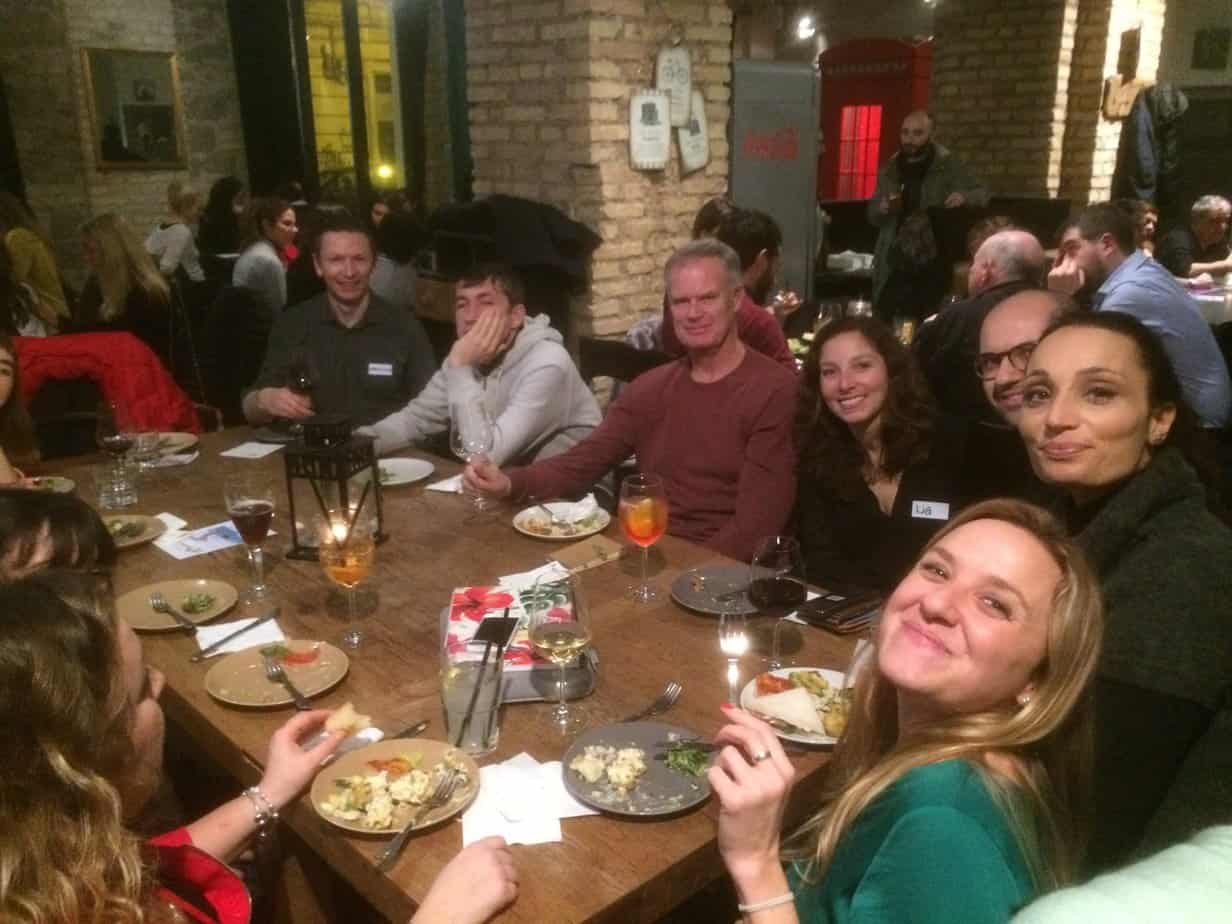
I understand. I retired to Italy in 2014 but under Pres. Obama. I liked the U.S. then. I moved to Italy, not from the U.S. It remains the best decision I ever made. To all you desperate dreamers out there, trust me. Living in Italy is as great as you imagine. Pasta amatriciana on a sun-splashed piazza. A glass of Montepulciano looking out at the Abruzzo countryside. People so kind they smile through their recession. Two thousand years of history on nearly every block. A slower lifestyle where friends, family and spare time trump money, status and possessions.
For me, it’s like heaven with better pizza. How many people are 68 years old and are the happiest they’ve ever been?
The slow process
However, before you buy your Lonely Planet: Italy, get set for a long, slow slog into expathood. Moving to Italy isn’t quite as easy as when I did it. And the questions and bureaucracy are endless. Taxes? Housing? Social Security? Insurance? Language?
The first question Pat asks inquirers is this:
“What visa will they qualify for?” she said. “We can find a loophole if they have some money to get them a student visa then we transfer them to a waiting list for work (visa). Most of them have work which is OK but most of their income is in the U.S. and not in Italy.
“They have to be clear that they know the path. You can’t reach the final step three years later and then you’re like, ‘I need a job.’”
Or you can retire here. The visa is called a residenza elettiva which allows you to live here under one condition: You do not work. It’s renewed every two years and as long as you have steady income or a healthy stock portfolio it’s easily renewable.
But not everyone escaping Trump is 65 and over. Pat gets inquiries from all age groups. They are desperate and, worse, a little naive.
“They have no idea the immigration of other worlds,” she said. “It’s ‘Oh, I can just come. What? I can only stay three months?’ I’m like, ‘Yeah. You want to build a fucking wall but then you expect every country to open their arms up to you?’”
Italy immigration has stiffened
Also, the political climate in Italy has changed. Two years ago, prime minister Giorgia Meloni won the election primarily on an anti-immigration platform. She is not shipping millions of immigrants back to where they came from. I am not hiding in my comfy flat two miles from the Colosseum. I still take my cappuccino on my wraparound balcony every morning.
But the immigration bureaucracy has grown since the Covid epidemic. According to Ivano Valeri, Pat’s relocation coordinator, before Covid a family seeking a visa needed an annual income of €38,000. Now it’s €32,000 for each family member.
For a student visa to study Italian before Covid, you needed no prior experience with the language. Now you need to show a B1 level certificate.
When I arrived in 2014, I received my codice fiscale, the Italian social security number, in Rome at my local comune, or government office. Now you must apply at an Italian consulate in the U.S. Keep in mind, you’ll be fighting tens of thousands of Americans who want the same thing.
“They didn’t change the law,” Ivano said. “They are using bureaucracy as a restriction.”

Higher costs
Cost is also a new factor. While Italy remains cheaper than the U.S., I hear property and rentals are skyrocketing. Pat said on the outskirts of Autostrada A90, also known as the Ring Road which separates Rome from the periphery, a one-bedroom condo with a kitchen, a balcony “and an elevator if you’re lucky,” she said, is €150,000 minimum. Inside the Ring Road, in a working-class neighborhood such as San Giovanni, a 50-70-square meter place goes for €250,000-€300,000.
She recently went apartment hunting in Trastevere, an historic, hip neighborhood popular with students. It was 50 square meters with two bedrooms and the entrance going straight into the kitchen.
“They wanted €2,000 (a month),” she said. “I said, ‘Excuse me?’ He said, ‘How much do you want to give me?’ I said, ‘I was being nice. I said €1,200. I was thinking more like €800.’ He goes, ‘€1,200? I’ll think about it and call you.
“I said, ‘If you don’t call me it’s even better.’”
Pat and Ivano agree. Don’t look in the major destinations like Rome, Florence and Milan. Puglia, the heel of Italy’s boot, is also becoming expensive. In fact, forget Tuscany altogether.
Think Le Marche, Abruzzo, Molise, Umbria. One couple found a house in Molise, the least-visited of Italy’s 20 regions, for €45,000. Another area we all agree on.
Rural Lazio.
Our fab five
Outside of Rome has dozens of cute, historic, less-expensive towns. Since Marina and I started TraveLazio last year, we have visited 44 of them. Here are our five favorites (in alphabetical order), all with links to the TraveLazio blogs:
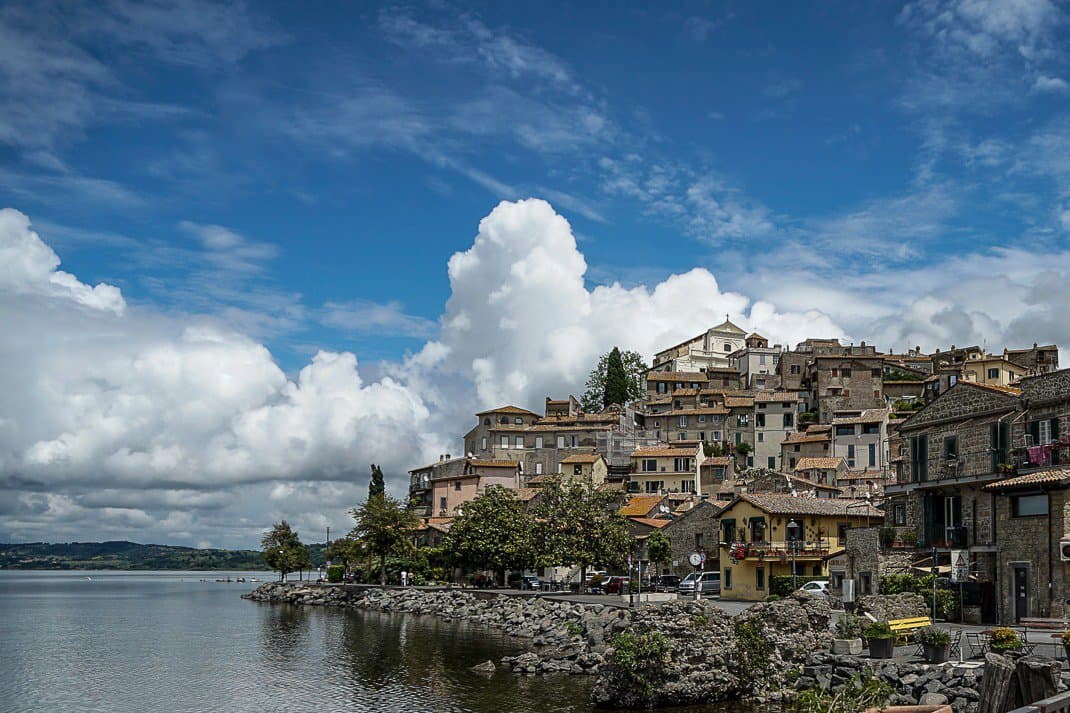
Anguillara Sabazia. I never liked the hit American sitcom “Everybody Loves Raymond” even though it was about a sportswriter and I was a sportswriter for 40 years. But I did like one aspect of the show. It chose the little Lazio lake town of Anguillara Sabazia for two of its episodes. Located just 16 miles (30 kilometers) northwest of Rome on Lake Bracciano, Anguillara is small-town Italy right out of central casting with a gorgeous lake right next to it. Walk the narrow, cobblestone alleys of the medieval center and around every corner is another beautiful view of Lake Bracciano. The lakefront is a spotless, wide swath lined with potted plants and benches for gazing at the calm water. With only 19,000 people, it’s smaller than the town of Bracciano six miles to the west. It also has a better lakefront.
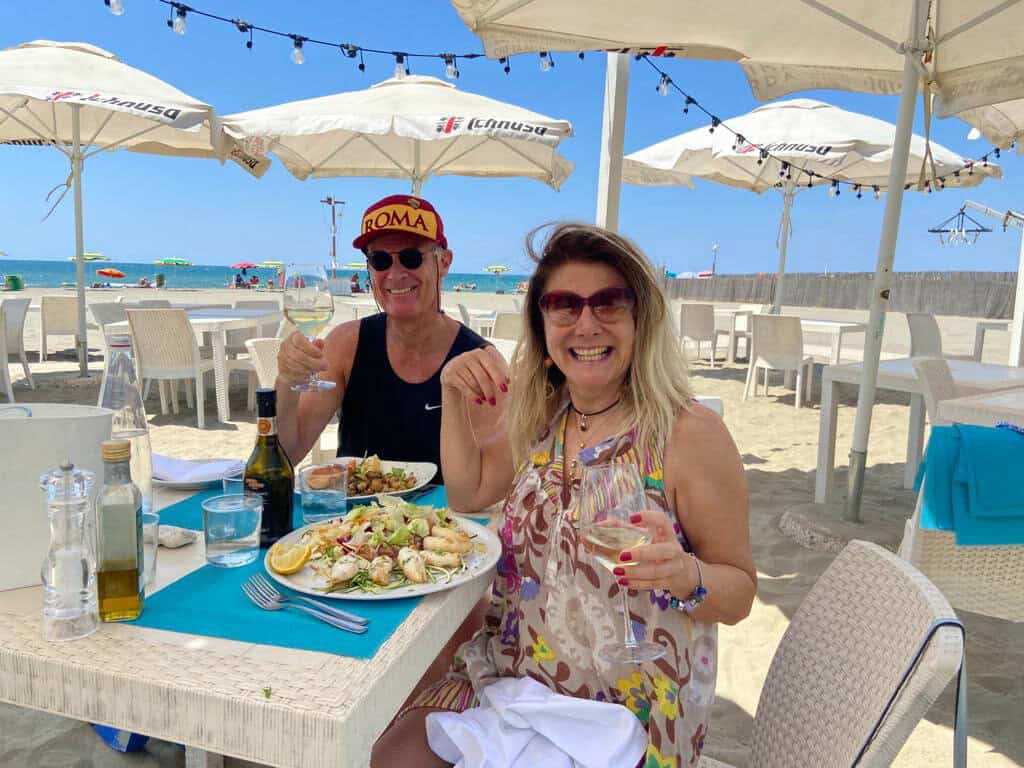
Fregene: Italy is famous for its beaches. It should with 4,723 miles of coastline. Stentino in Sardinia. Taormina in Sicily. Lama Monachile in Puglia. They’re all famous around Italy and beyond. But Rome has a perfectly good beach just a 30-minute drive away which Marina and I have used for years. In the mid-20th century, director Federico Fellini had a villa here. Writer Pier Paolo Pasolini and actor Marcello Mastroianni were frequent visitors. Fregene (pop. 6,445), located just eight miles (14 kilometers) north of Fiumicino Airport, has a long, swath of fine sand with nary a pebble underfoot. You won’t find a string of palm trees you’ll see elsewhere in Italy. What you’ll find is a clean and calm Tyrrhenian Sea, great seafood and solitude (if you go early).

Picinisco. D.H. Lawrence had it right all along. The famous British author traveled the world but chose a small hamlet on Lazio’s southern border to finish his famed novel, “The Lost Girl.” While he called Picinisco “primitive,” he also wrote about the raw beauty of Picinisco’s Valle di Comino. Located a 2 ½-hour drive from Rome, Picinisco (pop. 1,200) sits at the corner where Lazio, Molise and Abruzzo meet. It’s shouting distance from Abruzzo National Park and home to some of the best pecorino cheese in Italy. And where else in Italy can you stay in a 100-year-old B&B with a classically-trained chef cooking you meals?
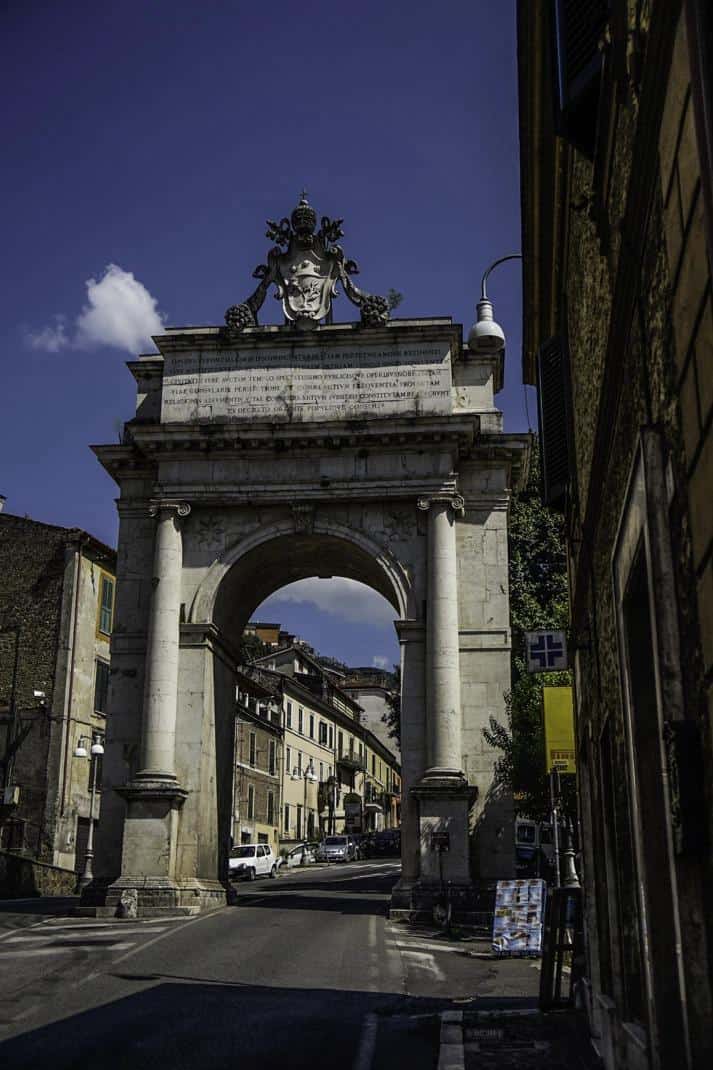
Subiaco: She was nearly as Hollywood as she was Italian. Gina Lollobrigida graced the silver screen and men’s walls through the middle of the 20th century, and her birthplace isn’t even the biggest draw in her hometown. Subiaco sits on a hill 40 miles east of Rome and is listed on the I Borghi Piu Bella d’Italia (The Most Beautiful Villages of Italy). Its old town is a warren of narrow alleys lined with sidewalk cafes and boutique shops. But the biggest attraction is Abbey Santa Scolastica, a huge working abbey with beautiful views of the Lazio countryside. If you drive about 20 miles east of town, you can visit Santuario Sacro Speco, a Benedictine abbey from the 11th century. Subiaco also serves as the trailhead for numerous hikes around the area. Maybe that’s how Gina kept in shape.
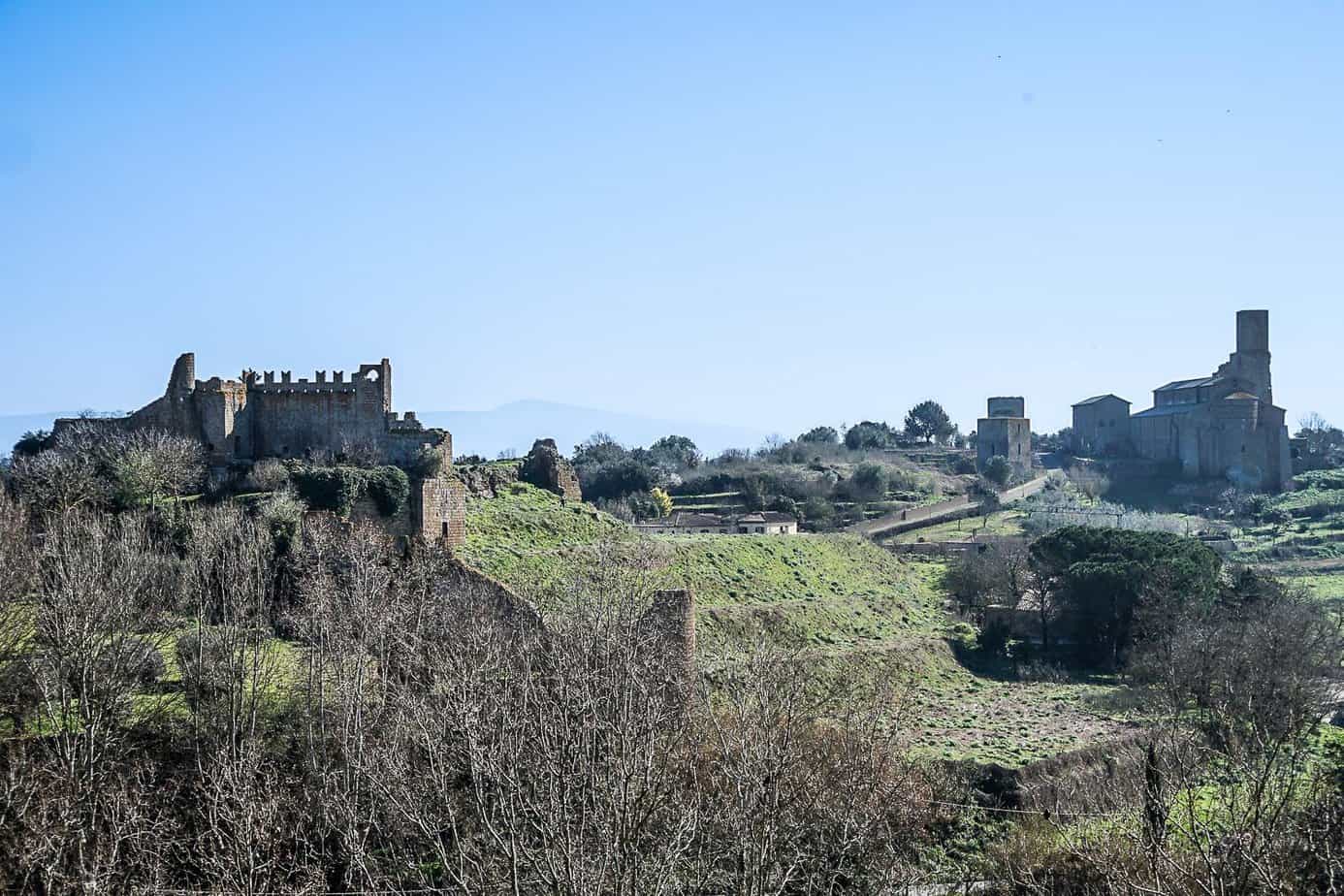
Tuscania: The name confuses people. We tell friends we’re going to Tuscania and they think we’re headed to Florence in Tuscany. Nope. Tuscania (pronounced toos-CAHN-ia) is in Lazio. It’s actually 70 miles (130 kilometers) from the Tuscan border and only 50 miles (93 kilometers) northwest of Rome. Tuscania (pop. 8,400) is an absolute gem of a stopover on the well-worn tourist route between Rome and Florence. Tuscania’s Old Town dates back to the Middle Ages and sports breathtaking views of the 8th century Church of St. Peter and the 13th century Castello del Rivellino. Work off fabulous local cuisine in the surrounding national park and the Old Town’s narrow windy roads where you can shop for ceramics in a town famous for them.
We all consider ourselves so very lucky to live in Italy, particularly after the election. If any of us had to move back to the U.S., we all agree on one word.
Devastation.
Expat worries
However, we still have our fears. Trump hates expats. Reports say he may force expats to include foreign income in our U.S. taxes. Will he bankrupt Social Security? Will the dollar plunge like the Cambodian riel against the euro?
We have found paradise and we don’t want it destroyed. That’s the picture Pat paints to fleeing Americans.
“I tell them I was deported to this country and it was the best thing that ever happened to me,” she said.
She got into trouble with the law as a teenager and has been in Italy since 2000. She expounds the same advantages we all do.
“The food, the air, the environment, the quality of life,” she said. “You won’t get rich in Italy but you definitely live a better life (with) quality and joy. It’s beautiful. You’ll never understand until you put your feet on the ground.”
She still goes back to her home in Schenectady, N.Y., but they aren’t pleasant homecomings.
“What changed for me is (when) I’m in the U.S., I am so depressed there,” she said. “My neighborhood has so many shootings. My friend’s daughter was just murdered. My neighbor’s two kids within two years were shot dead. I want my children here. I don’t want them living in America.”
Obviously, many others don’t, either. Ladies and gentleman, the line to Italy forms to the right.


November 12, 2024 @ 3:36 pm
I’m self deporting. At this point I’m agnostic on the destination….thinking central or South America for time zones and ease of remote work. Have a little Spanish and French so language not a total barrier.
November 12, 2024 @ 4:10 pm
Good for you, Mike. Let me know where you end up and how.
November 12, 2024 @ 6:20 pm
I am beyond disgusted but can’t leave until husband retires (4 years while America burns from the hellscape half our country voted for). I’ve been studying Italian for 4.5 years and coming over this winter for an immersion course. But I don’t have ancestry and am semi-retired so not sure I could even get a Visa when the time comes. Will be studying in Lucca in January.
November 13, 2024 @ 10:15 am
Bad timing for your husband. And in four years Italy’s immigration laws may stiffin, too. Keep studying. Find an Italian in your town to practice with.
November 12, 2024 @ 9:08 pm
Thank you for this insightful article. I’m the son of an Italian who (unfortunately) naturalized before I was born. Trying to find as law firm to discuss my options for
citizenship there as I plan to retire there.
November 13, 2024 @ 10:14 am
Good luck, Lorenzo. Citizenship is out of my realm. I’m eligible but won’t apply. It gives me no real advantage except to work and the Carta di Soggiorno for which I got approval allows me that. The problem is I’ve waited 18 months for the damn card and it still hasn’t arrived. Only in Italy.
November 13, 2024 @ 4:12 pm
Devastating indeed. Happy we made an escape plan – we have an italian house and a codice fiscale … just don’t have work all figured out. And we still have a son in high school. But if (when?) things deteriorate, I’ll be on the first plane. Graduation is July 2026.
November 13, 2024 @ 5:17 pm
You have an Italian house but may not move until 2026? Who’s in the house now?
November 14, 2024 @ 3:12 pm
Luckily we’re able to rent it, in season. It’s in the lakes region.
November 13, 2024 @ 5:33 pm
There is the 7% income tax now for 10 years if you move to municipalities under 20,000 in Southern Italy, but the impact of Italian income taxes should be thoroughly researched.
November 13, 2024 @ 10:19 pm
I agree this past election has given me a great fear for what the US will become under Trump. When I just saw he has appointed the “nutcase” Matt Gaetz as Attorney General I fear for my life!
I have been to Italy 4 times in the last 5 years.
Would like to find a rental outside of Florence or around Puglia. I’m 74 so the ERV is best for me.
Thanks
November 14, 2024 @ 7:17 am
Yes, Trump is picking up where he left off eight years ago when he hired an environmental chief who didn’t believe in global warming and a head of the Department of Education who didn’t believe in public schools. I wouldn’t let Matt Gaetz defend me on a parking ticket. And Mike Huckabee the ambassador to Israel? Does the ex-governor of Arkansas even have a passport?
If you get a place outside Florence you’ll likely need a car. That’s a major hassle, for parking if nothing else.
November 16, 2024 @ 12:11 am
I moved to Mexico about same time you moved to Italy but partner and I are on final steps for residency in Spain. That particular visa route is no longer possible so I’m thankful I started process last March. So grateful to be out.
November 16, 2024 @ 9:03 am
Thanks for the note, Rob, and congrats on being an immigrant. I am so thankful merely because I don’t want to be around Trump supporters. Just two nights ago I got in this vicious online argument with a guy defending the overturning of Wade vs. Roe, claiming it was unconstitutional. If I lived in the U.S., this would happen every day. In Europe it never happens — unless I’m dumb enough to go online. So how was life in Mexico? Why move to Spain?
November 27, 2024 @ 2:13 pm
We live in Denver and have retired. My husband is a dual-Italian citizen. Our main hurdle would be taxes, especially the wealth tax! We’ve started looking into it and wondered if you have any advice/experience. Is form 6166, the certificate of tax residency for US citizens a loophole?
November 27, 2024 @ 3:26 pm
Italian taxes are way too complicated for me to understand, let alone explain. I have my accountant handle it and she already has too many clients. I hate to do this but you’ll have to find online a tax accountant in Italy who speaks English. Good luck.
November 28, 2024 @ 4:07 am
Thanks! I’m on a quest.